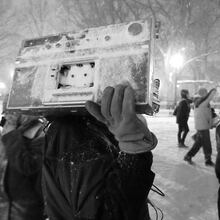By John Horn
Los Angeles Times
LOS ANGELES - F. Scott Fitzgerald’s “The Great Gatsby” is widely recognized as a literary masterwork. Yet as even the book’s editor, Maxwell Perkins, said to Fitzgerald about a draft of the 1925 novel, the title character “is somewhat vague.”
Hazy doesn’t work in cinema, so when director Baz Luhrmann decided to bring “Gatsby” to the screen, he and his creative team went on the filmmaking equivalent of an anthropological dig. The goal: unearth what was left unsaid in Fitzgerald’s slender tale of Jay Gatsby, a millionaire bootlegger, and his unrequited love for a married socialite, Daisy Buchanan.
The film, opening today, overflows with all the touches you’d expect from the director of “Moulin Rouge!” - elaborate production and costume design, modern music in a period setting, theatrical acting - while hitting the seminal scenes and lines in Fitzgerald’s classic.
But Luhrmann recognized the danger of missing “Gatsby’s” emotional forest for all of the novel’s expositional trees. So he, co-screenwriter Craig Pearce and a cast headed by Leonardo DiCaprio (who plays Gatsby), Carey Mulligan (Daisy) and Tobey Maguire (narrator Nick Carraway) looked for clues wherever they could be found - and then came to their own storytelling conclusions.
Luhrmann delved into Fitzgerald’s life, letters and other writings, ultimately relying heavily on “Trimalchio” - an early draft of “Gatsby” - and biographies of his wife, Zelda, whom the novelist described as the first American flapper.
While Gatsby’s famous bashes are even more excessive in Luhrmann’s imagination than in the novel, with fireworks choreographed to Gershwin’s “Rhapsody in Blue,” the director said he labored to keep the story intimate and immersive.
He filmed several sequences in long takes, as if “The Great Gatsby” were live theater, and shot it in 3-D; the stereoscopic technology, Luhrmann said, heightens the film’s emotions, moving the audience from spectators to participants. “It was our poetic glue,” the director said of 3-D.
The director briefly needed his own adhesive to keep the project from falling apart. Worried about its budget, Sony Pictures backed out (the film was ultimately co-produced by Warner Bros. and Village Roadshow), and numerous production delays, some tied to weather, postponed the film’s release.
Those hurdle behind him, Luhrmann and his team turned their attention to the film’s supporting characters: Daisy’s husband, Tom (Joel Edgerton); Tom’s mistress, Myrtle Wilson (Isla Fisher); Myrtle’s husband, George (Jason Clarke); and Daisy’s friend and accomplished golfer Jordan Baker (Elizabeth Debicki). The task, as DiCaprio said, was tying to sort out “the choose-your-own interpretation of who these people are.” “What makes ‘Gatsby’ the book that it is,” the actor said, “is that people still have conversations about it.”
Luhrmann said that adapting any well-known text will raise someone’s dander. And it may not just be his telling of the story that is faulted - his unconventional musical choices may prove polarizing.
Just as he used songs by Elton John, David Bowie and U2’s Bono in “Moulin Rouge!,” Luhrmann infused “The Great Gatsby” with tracks from an array of modern musicians - Florence Welch and Lana Del Rey, plus Kanye West and the husband-and-wife duo of Beyonce and Jay-Z (the last serves as an executive producer).
Luhrmann said criticism is inevitable whenever you touch a hallowed text, be it by Shakespeare or Fitzgerald. “If you go near anything, you are going to be tarred and feathered,” he said.
About the Author



